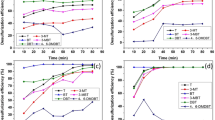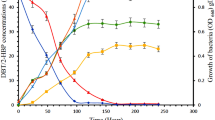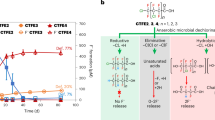Abstract
The development of biocatalytic desulfurization of petroleum fractions may allow its use in place of conventional hydrodesulfurization (HDS). Dibenzothiophene (DBT) is representative of a broad range of sulfur heterocycles found in petroleum that are recalcitrant to desulfurization via HDS. Rhodococcus sp. strain IGTS8 has the ability to convert DBT to 2-hydroxybiphenyl (HBP) with the release of inorganic sulfur. The conversion of DBT to HBP is catalyzed by a multienzyme pathway consisting of two mono-oxygenases and a desulfinase. The final reaction catalyzed by the desulfinase appears to be the rate limiting step in the pathway. Each of the enzymes has been purified to homogeneity and their kinetic and physical properties studied. Neither monooxygenase has a tightly bound cofactor and each requires an NADH-FMN oxidoreductase for activity. An NADH-FMN oxidoreductase has been purified from Rhodococcus and is a protein of approximately 25,000 molecular weight with no apparent sequence homology to any other protein in the databases. We describe a unique sulfur acquisition system that Rhodococcus uses to obtain sulfur from very stable heterocyclic molecules.
This is a preview of subscription content, access via your institution
Access options
Subscribe to this journal
Receive 12 print issues and online access
$209.00 per year
only $17.42 per issue
Buy this article
- Purchase on Springer Link
- Instant access to full article PDF
Prices may be subject to local taxes which are calculated during checkout
Similar content being viewed by others
References
Monticello, D.J. 1993. Biocatalytic desulfurization of petroleum and middle distillates. Environmental Progress 12: 1–4.
Monticello, D.J. 1994. Biocatalytic desulfurization, The biorefining of petroleum factors. Hydrocarbon Processing 2: 39–45.
Monticello, D.J. and Finnerty, W.R. 1985. Microbial desulfurization of fossil fuels. Ann. Rev. Microbiol. 39: 371–389.
Nelson, W.L. 1969. In Petroleum Refinery Engineering. 4th Edition. McGraw Hill, New York.
Kilbane, J.J. and Jackowski, K. 1992. Biodesulfurization of water-soluble coal-derived material by Rhodococcus rhodochrous IGTS8. Biotechnol. Bioeng. 40: 1107–1114.
Gallagher, J.R., Olson, E.S. and Stanley, D.C. 1993. Microbial desulfurization of dibenzothiophene: A sulfur-specific pathway. FEMS Microbiol. Lett. 107: 31–36.
Omori, T., Monna, L., Saiki, Y. and Kodama, T. 1992. Desulfurization of dibenzothiophene by Corynebacterium sp. strain SY1. Appl. Environ. Microbiol. 58: 911–915.
Olson, E.S., Stanley, D.C., Sharma, R.K. and Gallagher, JR. 1994. Microbial Desulfurization Mechanisms. PREPRINTS, Div. of Fuel Chem., ACS 39: 738–740.
Denome, S.A., Olson, E.S. and Young, K.D. 1993. Identification and cloning of genes involved in specific desulfurization of dibenzothiophene by Rhodococcus sp. strain IGTS8. Appl. Environ. Microbiol. 59: 2837–2843.
Denome, S.A., Oldfield, C., Nash, L.J. and Young, K.D. 1994. Characterization of the desulfurization genes from Rhodococcus sp. strain IGTS8. J. Bacteriol. 176: 6707–6716.
Piddington, C.S., Kovacevich, B.R. and Rambosek, J.R. 1995. Sequence and molecular characterization of a DNA region encoding the dibenzothiophene desulfurization operon of Rhodococcus sp. strain IGTS8. Appl. Environ. Microbiol. 61: 468–475.
Blanc, V., Lagneaux, D., Dider, P., Gil, P., Lacroix, P. and Crouzet, J. 1995. Cloning and analysis of structural genes from Streptomyces pristinaespiralis encoding enzymes involved in the conversion of Pristinamycin IIB to Pristinamycin IIA (PIIA): PIIA synthase and NADH: Riboflavin 5′-phosphate oxdoreductase. J. Bacteriol. 177: 5206–5214.
Xu, Y., Mortimer, M., Kahn, M., Brockman, F. and Xun, L. 1995. Cloning and sequencing of the gene for NTA monoxygenase from Chelotobacter heintzii . Abstracts of the 95th General Meeting of the American Society for Microbiology. Session 202, Q-281.
Ohshiro, T., Hine, Y. and Izumi, Y. 1994. Enzymatic desulfurization of dibenzo-thiophene by a cell-free system of Rhodococcus erythropolis D-1. FEMS Microbiol. Lett. 118: 341–344.
Ohshiro, T., Kanbayashi, Y., Hine, Y. and Izumi, Y. 1995. Involvement of flavin coenzyme in dibenzothiophene degrading enzyme system from Rhodococcus erythropolis D-1. Biosci. Biotech. Biochem. 59: 1349–1351.
Hastings, J.W., Portrikus, C.J., Gupta, S.C., Kurfurst, M. and Makemson, J.C. 1985. Biochemistry and physiology of bioluminescent bacteria. Adv. Microb. Physiol. 26: 235–291.
Meighen, E.A. 1988. Enzymes and genes from the lux operons of bioluminescent bacteria. Ann. Rev. Microbiol. 42: 151–176.
Fontecave, M., Eliasson, R. and Reichard, P. 1987. NAD(P)H: flavin oxidore-ductase of Escherchia coli . A ferric iron reductase participating in the generation of the free radical of ribonucleotide reductase. J. Biol. Chem. 262: 12325–12331.
Reichard, P. 1988. Interactions between deoxyribonucleotide and DNA synthesis. Ann. Rev. Biochem. 57: 349–374.
Kendrew, S.G., Harding, S.E., Hopwood, D.A. and Marsh, E.N.G. 1995. Identification of a flavin: NADH oxidoreductase involved in the biosynthesis of actinorhodin. J. Biol. Chem. 270: 17339–17343.
Thibaut, D., Ratet, N., Bisch, D., Faucher, D., Debussche, L. and Blanche, F. 1995. Purification of the two enzyme system catalyzing the oxidation of the D-proline residue of pristinamycin IIB during the last step of pristinamycin IIA biosynthesis. J. Bacteriol. 177: 5199–5205.
Holland, H.L. 1988. Chiral sulfoxidation by biotransformation of organic sulfides. Chem. Rev. 88: 473–485.
Light, D.R., Waxman, D.J. and Walsh, C. 1982. Studies on the chirality of sulfoxidation catalyzed by bacterial flavoenzyme cyclohexanone monooxygenase and hog liver flavin adenine dinucleotide containing monooxygenase. Biochemistry 21: 2490–2498.
Lee, K., Brand, J.M. and Gibson, D.T. 1995. Stereospecific sulfoxidation by toluene and naphthalene dioxygenases. Biochem. Biophys. Res. Comm. 212: 9–15.
Duggleby, R.G. 1995. Analysis of enzyme progress curves by nonlinear regression. Methods Enzymol. 249: 61–90.
Massey, V. 1994. Activation of molecular oxygen by flavins and flavoproteins. J. Biol. Chem. 269: 22549–22462.
Kemal, C., Chan, T.W. and Bruice, T.C. 1977. Reaction of 3O2 with dihydroflavins. 1. N3,5-dimethyl-1,5-dihydrolumiflavin and 1,5-dihydroisoalloxazines. J. Am. Chem. Soc. 99: 7272–7286.
Mason, J.R. and Cammack, R. 1992. The electron-transport proteins of hydroxylating bacterial dioxygenases. Annu. Rev. Microbiol. 46: 277–305.
Harayama, S., Kok, M. and Neidle, E.L. 1992. Functional and evolutionary relationships among diverse oxygenases. Annu. Rev. Microbiol. 46: 565–601.
Batie, C.J., Ballou, D.P. and Correll, C.C. 1992. Phthalate dioxygenase reductase and related flavin-iron-sulfur containing electron transferases. pp. 543–556 in Chemistry and Biochemistry of Flavoproteins, Müller, F. (ed.). CRC Press, Boca Raton, FL.
Miles, E. and Meister, A. 1967. The mechanism of the reaction of ß-hydroxyaspartate with L-aspartate ß-decarboxylase. A new type of pyridoxal 5′-phosphate-enzyme inhibition. Biochemistry 6: 1734–1743.
Finnerty, W.R. 1992. The biology and genetics of the genus Rhodococcus . Annu. Rev. Microbiol. 46: 193–218.
Warhurst, A.M. and Fewson, C.A. 1994. Biotransformations catalyzed by the genus Rhodococcus. Crit. Rev. Biotechnol. 14: 29–73.
Li, M.Z., Squires, C.H., Monticello, D.J. and Childs, J.D. 1996. Genetic analysis of the dsz promoter and associated regulatory regions of Rhodococcus erythropolis strain IGTS8. J. Bacteriol. In press.
Author information
Authors and Affiliations
Rights and permissions
About this article
Cite this article
Gray, K., Pogrebinsky, O., Mrachko, G. et al. Molecular mechanisms of biocatalytic desulfurization of fossil fuels. Nat Biotechnol 14, 1705–1709 (1996). https://doi.org/10.1038/nbt1296-1705
Received:
Accepted:
Issue Date:
DOI: https://doi.org/10.1038/nbt1296-1705
This article is cited by
-
Biodesulfurization of organosulfur compounds by a trehalose biosurfactant producing Gordonia sp. isolated from crude oil contaminated soil
World Journal of Microbiology and Biotechnology (2024)
-
The complete genome sequence of the nitrile biocatalyst Rhodococcus rhodochrous ATCC BAA-870
BMC Genomics (2020)
-
Post-functionalization of dibenzothiophene to functionalized biphenyls via a photoinduced thia-Baeyer-Villiger oxidation
Nature Communications (2020)
-
A novel spectrophotometric method for simultaneous estimation of dibenzothiophene and 2-hydroxybiphenyl in their mixed spectrum and its application in screening of specific biodesulfurizing microbes
3 Biotech (2020)
-
Thermophilic biodesulfurization and its application in oil desulfurization
Applied Microbiology and Biotechnology (2018)



